Analysis of Leadership Styles and Path-Goal Theory in Organizations
VerifiedAdded on 2019/11/12
|7
|1808
|154
Essay
AI Summary
This essay provides an overview of leadership styles and the path-goal theory. It explores the concept of leadership as a means of influencing individuals to achieve specific goals. The essay delves into different leadership styles, including directive, supportive, participative, and achievement-oriented approaches. It analyzes the path-goal theory, highlighting its application and impact on employee motivation and performance within organizations. The discussion includes a review of articles related to leadership and the path-goal theory, such as those by Leana Polston and Hyatt Malik, to support the analysis. The essay concludes by emphasizing the significance of flexible leadership techniques and styles to improve employee performance and achieve organizational goals, underscoring the importance of leadership in fostering employee satisfaction and organizational growth. The essay also discusses how the application of different leadership styles depends on the situation and circumstances and the findings of the reports mentioned above also revealed the significance of the leadership styles with regard to the motivation and employee satisfaction in the organization.

Paraphrase This Document
Need a fresh take? Get an instant paraphrase of this document with our AI Paraphraser
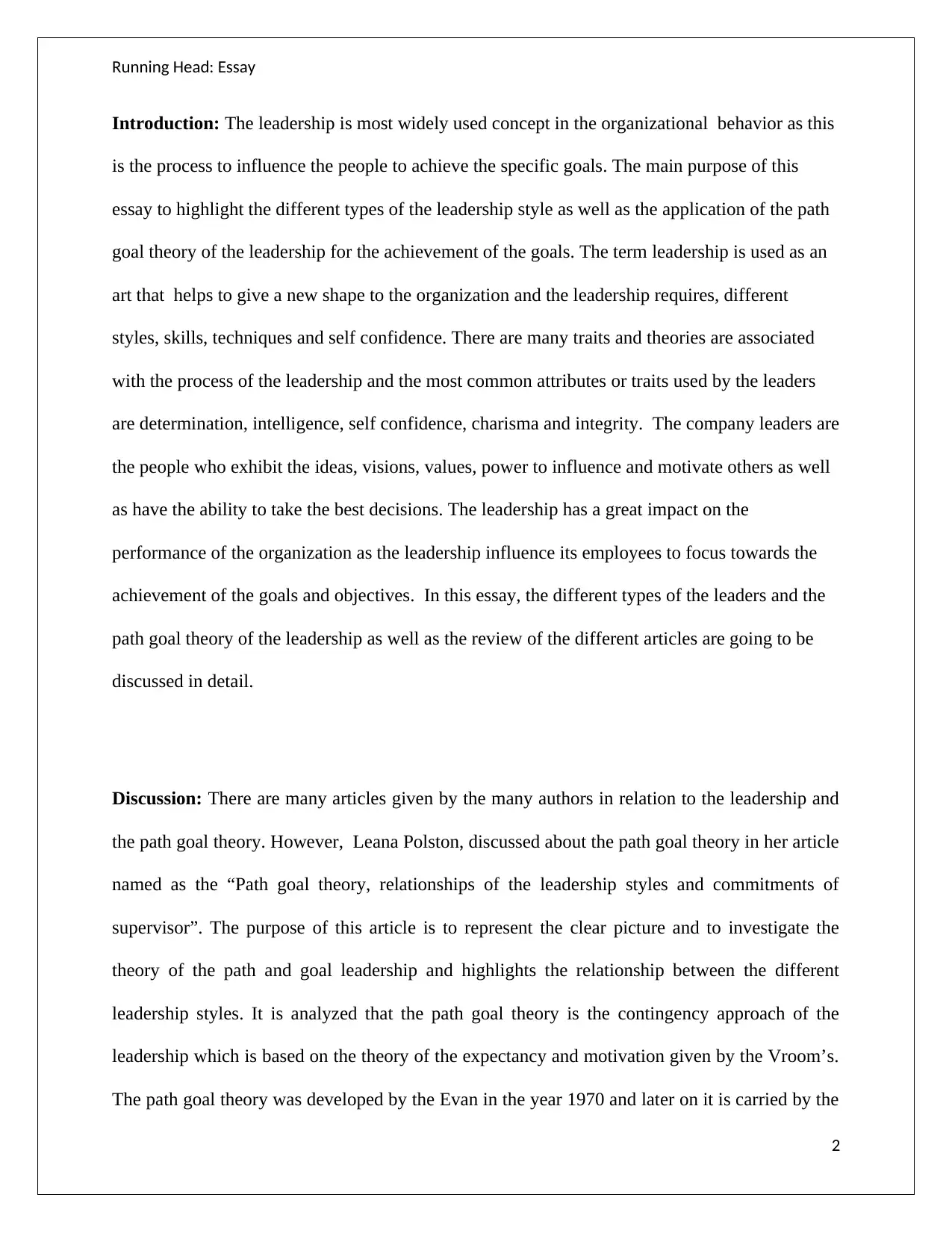
Running Head: Essay
Introduction: The leadership is most widely used concept in the organizational behavior as this
is the process to influence the people to achieve the specific goals. The main purpose of this
essay to highlight the different types of the leadership style as well as the application of the path
goal theory of the leadership for the achievement of the goals. The term leadership is used as an
art that helps to give a new shape to the organization and the leadership requires, different
styles, skills, techniques and self confidence. There are many traits and theories are associated
with the process of the leadership and the most common attributes or traits used by the leaders
are determination, intelligence, self confidence, charisma and integrity. The company leaders are
the people who exhibit the ideas, visions, values, power to influence and motivate others as well
as have the ability to take the best decisions. The leadership has a great impact on the
performance of the organization as the leadership influence its employees to focus towards the
achievement of the goals and objectives. In this essay, the different types of the leaders and the
path goal theory of the leadership as well as the review of the different articles are going to be
discussed in detail.
Discussion: There are many articles given by the many authors in relation to the leadership and
the path goal theory. However, Leana Polston, discussed about the path goal theory in her article
named as the “Path goal theory, relationships of the leadership styles and commitments of
supervisor”. The purpose of this article is to represent the clear picture and to investigate the
theory of the path and goal leadership and highlights the relationship between the different
leadership styles. It is analyzed that the path goal theory is the contingency approach of the
leadership which is based on the theory of the expectancy and motivation given by the Vroom’s.
The path goal theory was developed by the Evan in the year 1970 and later on it is carried by the
2
Introduction: The leadership is most widely used concept in the organizational behavior as this
is the process to influence the people to achieve the specific goals. The main purpose of this
essay to highlight the different types of the leadership style as well as the application of the path
goal theory of the leadership for the achievement of the goals. The term leadership is used as an
art that helps to give a new shape to the organization and the leadership requires, different
styles, skills, techniques and self confidence. There are many traits and theories are associated
with the process of the leadership and the most common attributes or traits used by the leaders
are determination, intelligence, self confidence, charisma and integrity. The company leaders are
the people who exhibit the ideas, visions, values, power to influence and motivate others as well
as have the ability to take the best decisions. The leadership has a great impact on the
performance of the organization as the leadership influence its employees to focus towards the
achievement of the goals and objectives. In this essay, the different types of the leaders and the
path goal theory of the leadership as well as the review of the different articles are going to be
discussed in detail.
Discussion: There are many articles given by the many authors in relation to the leadership and
the path goal theory. However, Leana Polston, discussed about the path goal theory in her article
named as the “Path goal theory, relationships of the leadership styles and commitments of
supervisor”. The purpose of this article is to represent the clear picture and to investigate the
theory of the path and goal leadership and highlights the relationship between the different
leadership styles. It is analyzed that the path goal theory is the contingency approach of the
leadership which is based on the theory of the expectancy and motivation given by the Vroom’s.
The path goal theory was developed by the Evan in the year 1970 and later on it is carried by the
2
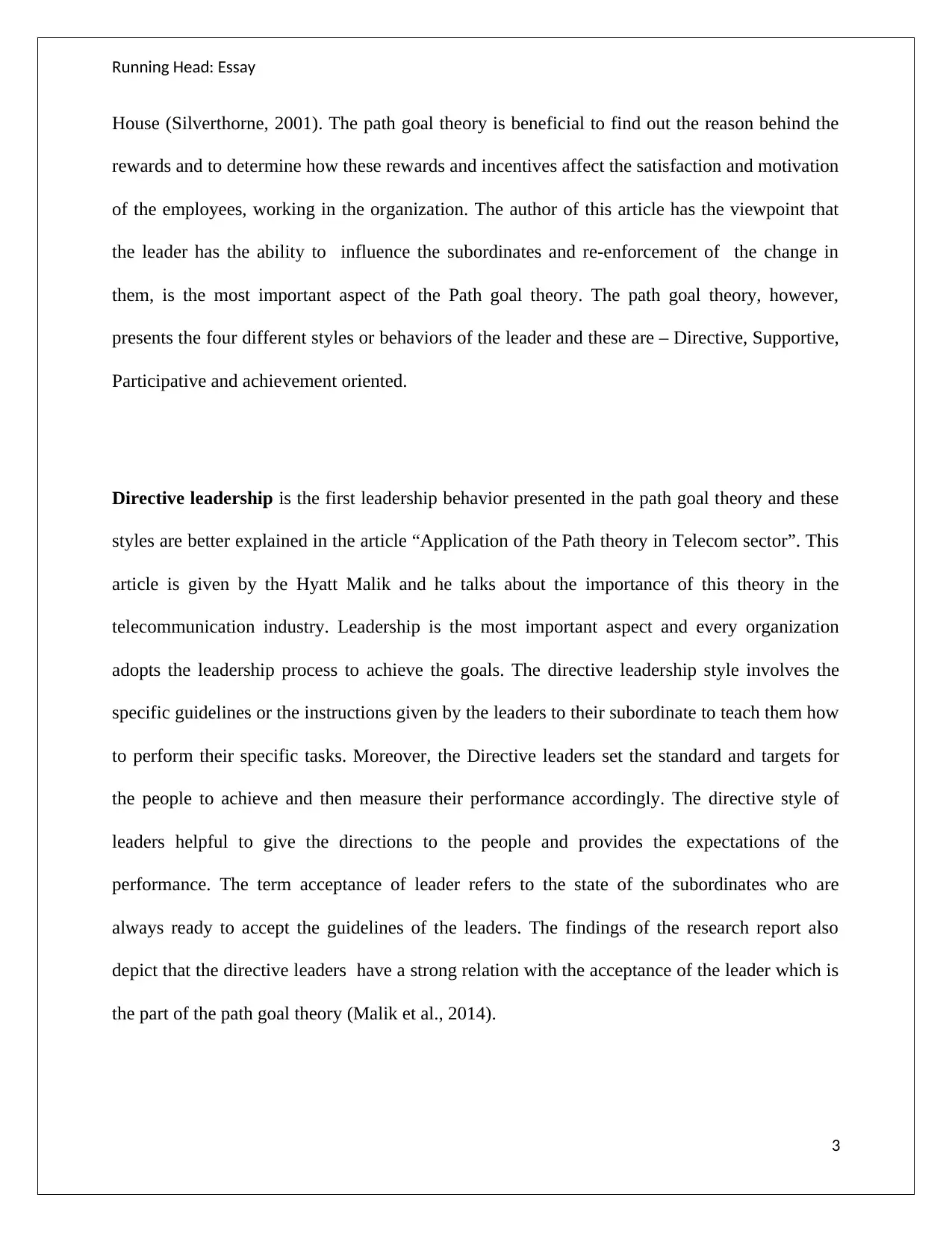
Running Head: Essay
House (Silverthorne, 2001). The path goal theory is beneficial to find out the reason behind the
rewards and to determine how these rewards and incentives affect the satisfaction and motivation
of the employees, working in the organization. The author of this article has the viewpoint that
the leader has the ability to influence the subordinates and re-enforcement of the change in
them, is the most important aspect of the Path goal theory. The path goal theory, however,
presents the four different styles or behaviors of the leader and these are – Directive, Supportive,
Participative and achievement oriented.
Directive leadership is the first leadership behavior presented in the path goal theory and these
styles are better explained in the article “Application of the Path theory in Telecom sector”. This
article is given by the Hyatt Malik and he talks about the importance of this theory in the
telecommunication industry. Leadership is the most important aspect and every organization
adopts the leadership process to achieve the goals. The directive leadership style involves the
specific guidelines or the instructions given by the leaders to their subordinate to teach them how
to perform their specific tasks. Moreover, the Directive leaders set the standard and targets for
the people to achieve and then measure their performance accordingly. The directive style of
leaders helpful to give the directions to the people and provides the expectations of the
performance. The term acceptance of leader refers to the state of the subordinates who are
always ready to accept the guidelines of the leaders. The findings of the research report also
depict that the directive leaders have a strong relation with the acceptance of the leader which is
the part of the path goal theory (Malik et al., 2014).
3
House (Silverthorne, 2001). The path goal theory is beneficial to find out the reason behind the
rewards and to determine how these rewards and incentives affect the satisfaction and motivation
of the employees, working in the organization. The author of this article has the viewpoint that
the leader has the ability to influence the subordinates and re-enforcement of the change in
them, is the most important aspect of the Path goal theory. The path goal theory, however,
presents the four different styles or behaviors of the leader and these are – Directive, Supportive,
Participative and achievement oriented.
Directive leadership is the first leadership behavior presented in the path goal theory and these
styles are better explained in the article “Application of the Path theory in Telecom sector”. This
article is given by the Hyatt Malik and he talks about the importance of this theory in the
telecommunication industry. Leadership is the most important aspect and every organization
adopts the leadership process to achieve the goals. The directive leadership style involves the
specific guidelines or the instructions given by the leaders to their subordinate to teach them how
to perform their specific tasks. Moreover, the Directive leaders set the standard and targets for
the people to achieve and then measure their performance accordingly. The directive style of
leaders helpful to give the directions to the people and provides the expectations of the
performance. The term acceptance of leader refers to the state of the subordinates who are
always ready to accept the guidelines of the leaders. The findings of the research report also
depict that the directive leaders have a strong relation with the acceptance of the leader which is
the part of the path goal theory (Malik et al., 2014).
3
⊘ This is a preview!⊘
Do you want full access?
Subscribe today to unlock all pages.

Trusted by 1+ million students worldwide
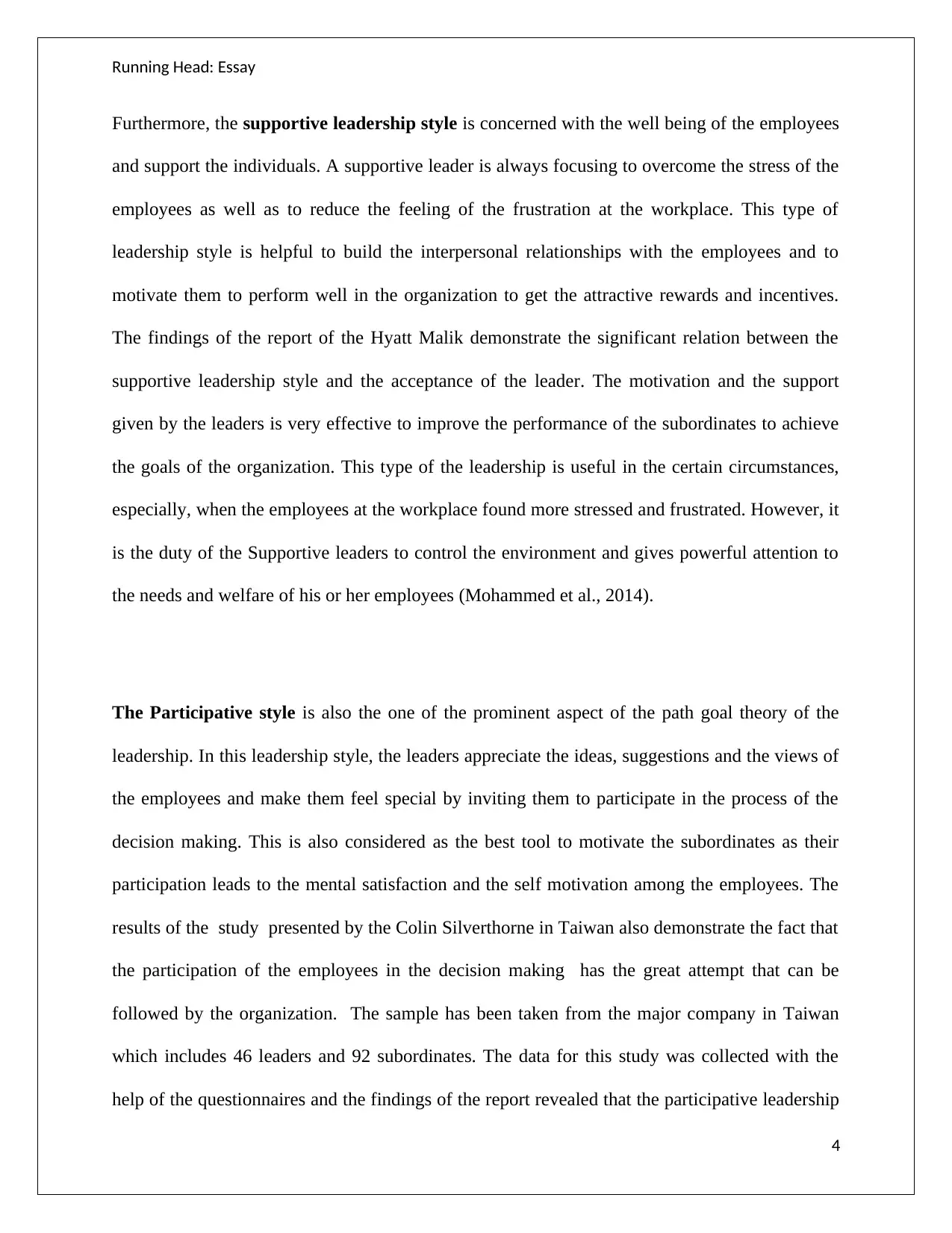
Running Head: Essay
Furthermore, the supportive leadership style is concerned with the well being of the employees
and support the individuals. A supportive leader is always focusing to overcome the stress of the
employees as well as to reduce the feeling of the frustration at the workplace. This type of
leadership style is helpful to build the interpersonal relationships with the employees and to
motivate them to perform well in the organization to get the attractive rewards and incentives.
The findings of the report of the Hyatt Malik demonstrate the significant relation between the
supportive leadership style and the acceptance of the leader. The motivation and the support
given by the leaders is very effective to improve the performance of the subordinates to achieve
the goals of the organization. This type of the leadership is useful in the certain circumstances,
especially, when the employees at the workplace found more stressed and frustrated. However, it
is the duty of the Supportive leaders to control the environment and gives powerful attention to
the needs and welfare of his or her employees (Mohammed et al., 2014).
The Participative style is also the one of the prominent aspect of the path goal theory of the
leadership. In this leadership style, the leaders appreciate the ideas, suggestions and the views of
the employees and make them feel special by inviting them to participate in the process of the
decision making. This is also considered as the best tool to motivate the subordinates as their
participation leads to the mental satisfaction and the self motivation among the employees. The
results of the study presented by the Colin Silverthorne in Taiwan also demonstrate the fact that
the participation of the employees in the decision making has the great attempt that can be
followed by the organization. The sample has been taken from the major company in Taiwan
which includes 46 leaders and 92 subordinates. The data for this study was collected with the
help of the questionnaires and the findings of the report revealed that the participative leadership
4
Furthermore, the supportive leadership style is concerned with the well being of the employees
and support the individuals. A supportive leader is always focusing to overcome the stress of the
employees as well as to reduce the feeling of the frustration at the workplace. This type of
leadership style is helpful to build the interpersonal relationships with the employees and to
motivate them to perform well in the organization to get the attractive rewards and incentives.
The findings of the report of the Hyatt Malik demonstrate the significant relation between the
supportive leadership style and the acceptance of the leader. The motivation and the support
given by the leaders is very effective to improve the performance of the subordinates to achieve
the goals of the organization. This type of the leadership is useful in the certain circumstances,
especially, when the employees at the workplace found more stressed and frustrated. However, it
is the duty of the Supportive leaders to control the environment and gives powerful attention to
the needs and welfare of his or her employees (Mohammed et al., 2014).
The Participative style is also the one of the prominent aspect of the path goal theory of the
leadership. In this leadership style, the leaders appreciate the ideas, suggestions and the views of
the employees and make them feel special by inviting them to participate in the process of the
decision making. This is also considered as the best tool to motivate the subordinates as their
participation leads to the mental satisfaction and the self motivation among the employees. The
results of the study presented by the Colin Silverthorne in Taiwan also demonstrate the fact that
the participation of the employees in the decision making has the great attempt that can be
followed by the organization. The sample has been taken from the major company in Taiwan
which includes 46 leaders and 92 subordinates. The data for this study was collected with the
help of the questionnaires and the findings of the report revealed that the participative leadership
4
Paraphrase This Document
Need a fresh take? Get an instant paraphrase of this document with our AI Paraphraser
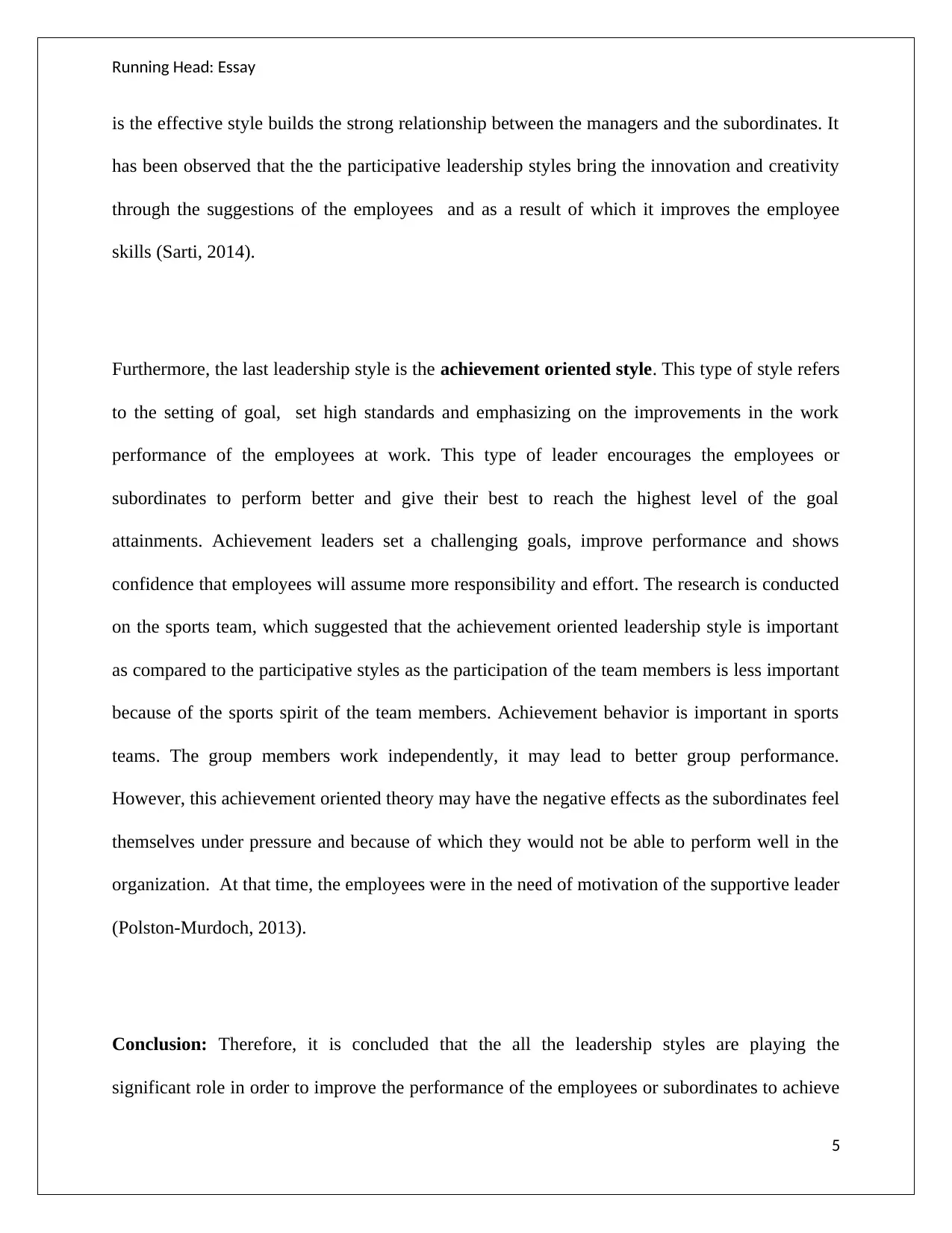
Running Head: Essay
is the effective style builds the strong relationship between the managers and the subordinates. It
has been observed that the the participative leadership styles bring the innovation and creativity
through the suggestions of the employees and as a result of which it improves the employee
skills (Sarti, 2014).
Furthermore, the last leadership style is the achievement oriented style. This type of style refers
to the setting of goal, set high standards and emphasizing on the improvements in the work
performance of the employees at work. This type of leader encourages the employees or
subordinates to perform better and give their best to reach the highest level of the goal
attainments. Achievement leaders set a challenging goals, improve performance and shows
confidence that employees will assume more responsibility and effort. The research is conducted
on the sports team, which suggested that the achievement oriented leadership style is important
as compared to the participative styles as the participation of the team members is less important
because of the sports spirit of the team members. Achievement behavior is important in sports
teams. The group members work independently, it may lead to better group performance.
However, this achievement oriented theory may have the negative effects as the subordinates feel
themselves under pressure and because of which they would not be able to perform well in the
organization. At that time, the employees were in the need of motivation of the supportive leader
(Polston-Murdoch, 2013).
Conclusion: Therefore, it is concluded that the all the leadership styles are playing the
significant role in order to improve the performance of the employees or subordinates to achieve
5
is the effective style builds the strong relationship between the managers and the subordinates. It
has been observed that the the participative leadership styles bring the innovation and creativity
through the suggestions of the employees and as a result of which it improves the employee
skills (Sarti, 2014).
Furthermore, the last leadership style is the achievement oriented style. This type of style refers
to the setting of goal, set high standards and emphasizing on the improvements in the work
performance of the employees at work. This type of leader encourages the employees or
subordinates to perform better and give their best to reach the highest level of the goal
attainments. Achievement leaders set a challenging goals, improve performance and shows
confidence that employees will assume more responsibility and effort. The research is conducted
on the sports team, which suggested that the achievement oriented leadership style is important
as compared to the participative styles as the participation of the team members is less important
because of the sports spirit of the team members. Achievement behavior is important in sports
teams. The group members work independently, it may lead to better group performance.
However, this achievement oriented theory may have the negative effects as the subordinates feel
themselves under pressure and because of which they would not be able to perform well in the
organization. At that time, the employees were in the need of motivation of the supportive leader
(Polston-Murdoch, 2013).
Conclusion: Therefore, it is concluded that the all the leadership styles are playing the
significant role in order to improve the performance of the employees or subordinates to achieve
5
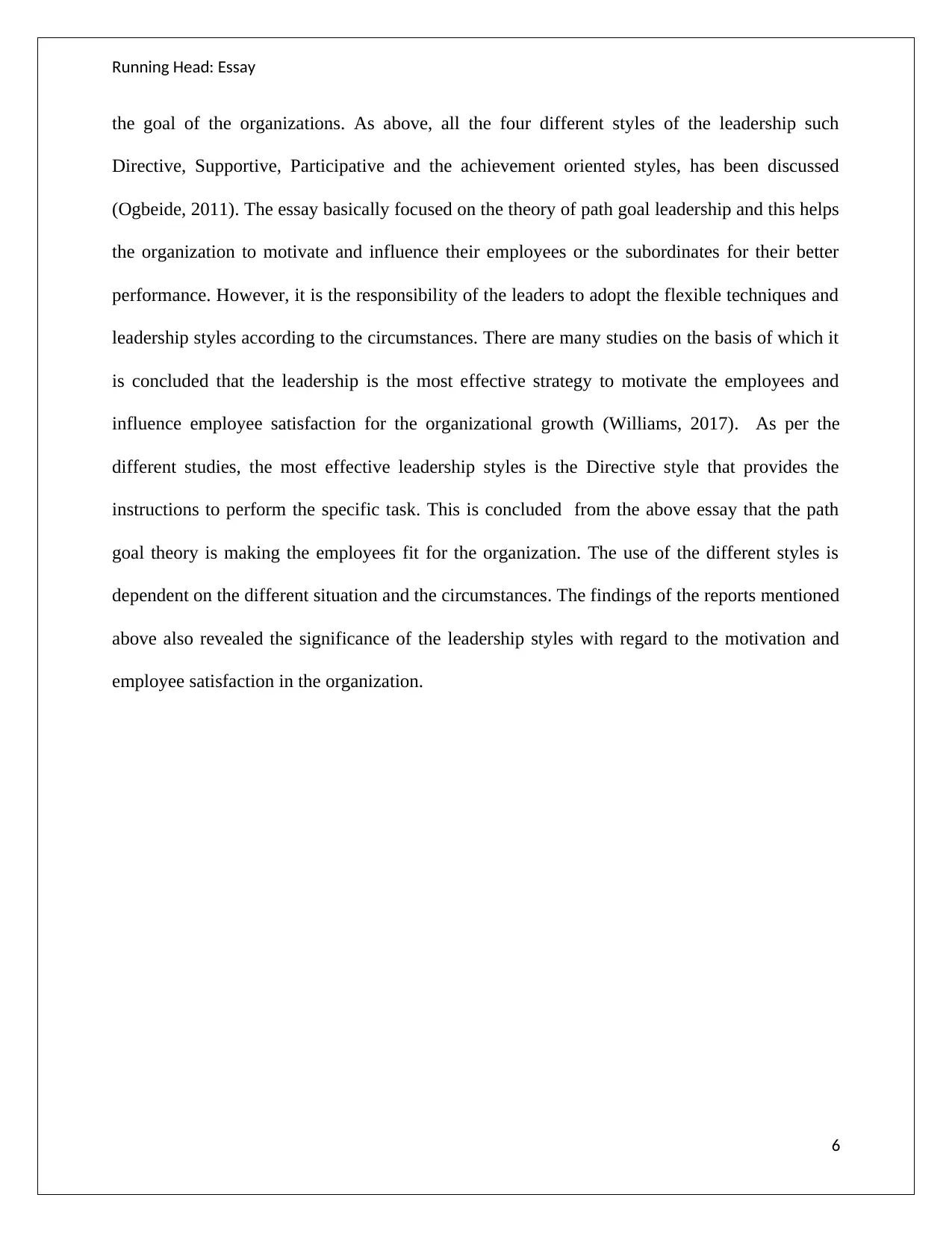
Running Head: Essay
the goal of the organizations. As above, all the four different styles of the leadership such
Directive, Supportive, Participative and the achievement oriented styles, has been discussed
(Ogbeide, 2011). The essay basically focused on the theory of path goal leadership and this helps
the organization to motivate and influence their employees or the subordinates for their better
performance. However, it is the responsibility of the leaders to adopt the flexible techniques and
leadership styles according to the circumstances. There are many studies on the basis of which it
is concluded that the leadership is the most effective strategy to motivate the employees and
influence employee satisfaction for the organizational growth (Williams, 2017). As per the
different studies, the most effective leadership styles is the Directive style that provides the
instructions to perform the specific task. This is concluded from the above essay that the path
goal theory is making the employees fit for the organization. The use of the different styles is
dependent on the different situation and the circumstances. The findings of the reports mentioned
above also revealed the significance of the leadership styles with regard to the motivation and
employee satisfaction in the organization.
6
the goal of the organizations. As above, all the four different styles of the leadership such
Directive, Supportive, Participative and the achievement oriented styles, has been discussed
(Ogbeide, 2011). The essay basically focused on the theory of path goal leadership and this helps
the organization to motivate and influence their employees or the subordinates for their better
performance. However, it is the responsibility of the leaders to adopt the flexible techniques and
leadership styles according to the circumstances. There are many studies on the basis of which it
is concluded that the leadership is the most effective strategy to motivate the employees and
influence employee satisfaction for the organizational growth (Williams, 2017). As per the
different studies, the most effective leadership styles is the Directive style that provides the
instructions to perform the specific task. This is concluded from the above essay that the path
goal theory is making the employees fit for the organization. The use of the different styles is
dependent on the different situation and the circumstances. The findings of the reports mentioned
above also revealed the significance of the leadership styles with regard to the motivation and
employee satisfaction in the organization.
6
⊘ This is a preview!⊘
Do you want full access?
Subscribe today to unlock all pages.

Trusted by 1+ million students worldwide
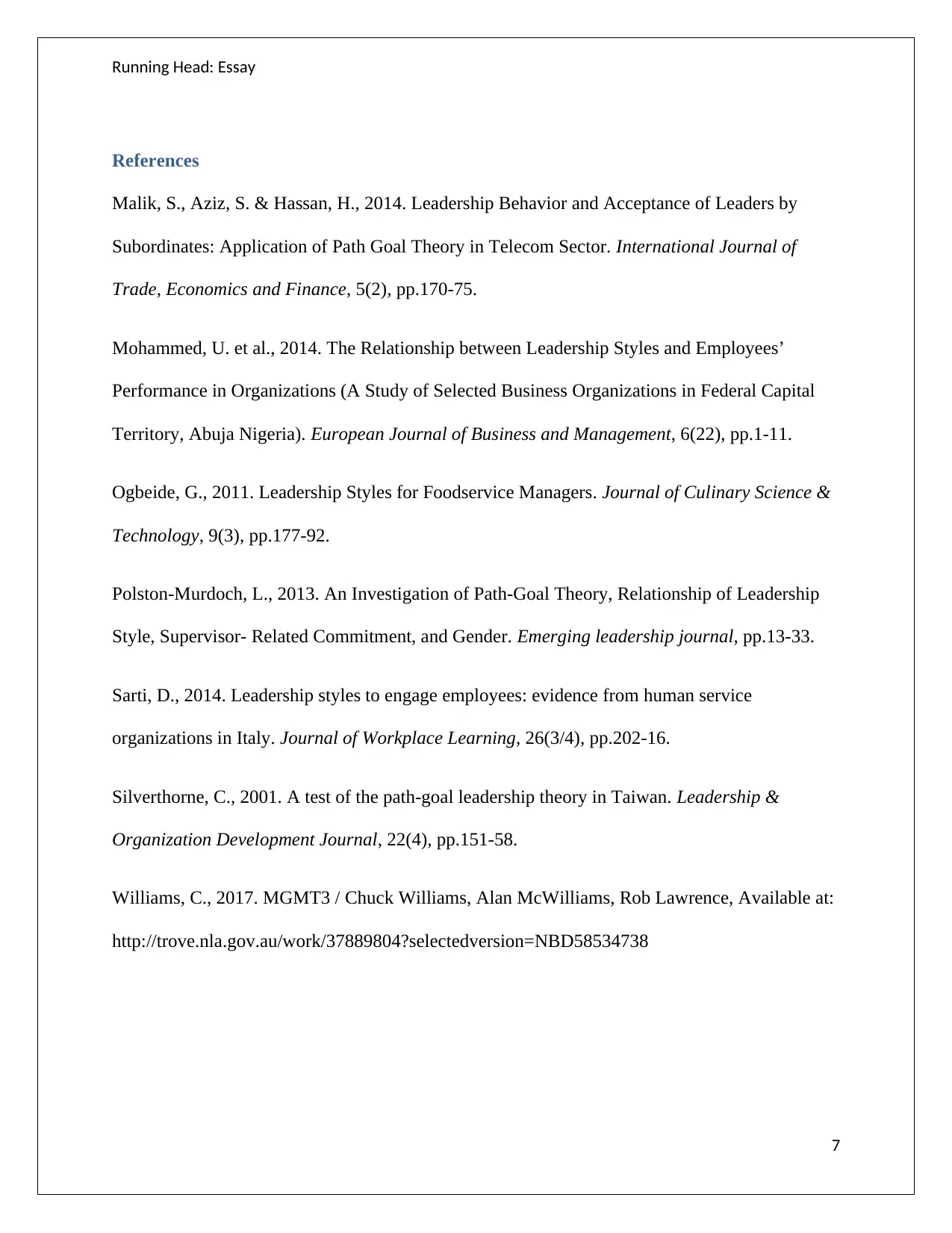
Running Head: Essay
References
Malik, S., Aziz, S. & Hassan, H., 2014. Leadership Behavior and Acceptance of Leaders by
Subordinates: Application of Path Goal Theory in Telecom Sector. International Journal of
Trade, Economics and Finance, 5(2), pp.170-75.
Mohammed, U. et al., 2014. The Relationship between Leadership Styles and Employees’
Performance in Organizations (A Study of Selected Business Organizations in Federal Capital
Territory, Abuja Nigeria). European Journal of Business and Management, 6(22), pp.1-11.
Ogbeide, G., 2011. Leadership Styles for Foodservice Managers. Journal of Culinary Science &
Technology, 9(3), pp.177-92.
Polston-Murdoch, L., 2013. An Investigation of Path-Goal Theory, Relationship of Leadership
Style, Supervisor- Related Commitment, and Gender. Emerging leadership journal, pp.13-33.
Sarti, D., 2014. Leadership styles to engage employees: evidence from human service
organizations in Italy. Journal of Workplace Learning, 26(3/4), pp.202-16.
Silverthorne, C., 2001. A test of the path-goal leadership theory in Taiwan. Leadership &
Organization Development Journal, 22(4), pp.151-58.
Williams, C., 2017. MGMT3 / Chuck Williams, Alan McWilliams, Rob Lawrence, Available at:
http://trove.nla.gov.au/work/37889804?selectedversion=NBD58534738
7
References
Malik, S., Aziz, S. & Hassan, H., 2014. Leadership Behavior and Acceptance of Leaders by
Subordinates: Application of Path Goal Theory in Telecom Sector. International Journal of
Trade, Economics and Finance, 5(2), pp.170-75.
Mohammed, U. et al., 2014. The Relationship between Leadership Styles and Employees’
Performance in Organizations (A Study of Selected Business Organizations in Federal Capital
Territory, Abuja Nigeria). European Journal of Business and Management, 6(22), pp.1-11.
Ogbeide, G., 2011. Leadership Styles for Foodservice Managers. Journal of Culinary Science &
Technology, 9(3), pp.177-92.
Polston-Murdoch, L., 2013. An Investigation of Path-Goal Theory, Relationship of Leadership
Style, Supervisor- Related Commitment, and Gender. Emerging leadership journal, pp.13-33.
Sarti, D., 2014. Leadership styles to engage employees: evidence from human service
organizations in Italy. Journal of Workplace Learning, 26(3/4), pp.202-16.
Silverthorne, C., 2001. A test of the path-goal leadership theory in Taiwan. Leadership &
Organization Development Journal, 22(4), pp.151-58.
Williams, C., 2017. MGMT3 / Chuck Williams, Alan McWilliams, Rob Lawrence, Available at:
http://trove.nla.gov.au/work/37889804?selectedversion=NBD58534738
7
1 out of 7
Related Documents
Your All-in-One AI-Powered Toolkit for Academic Success.
+13062052269
info@desklib.com
Available 24*7 on WhatsApp / Email
![[object Object]](/_next/static/media/star-bottom.7253800d.svg)
Unlock your academic potential
Copyright © 2020–2025 A2Z Services. All Rights Reserved. Developed and managed by ZUCOL.




